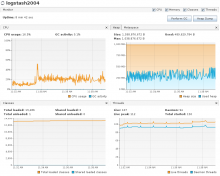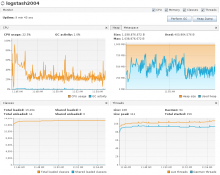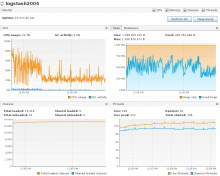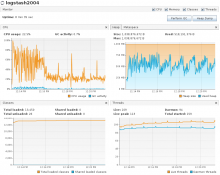During investigation of https://wikitech.wikimedia.org/w/index.php?title=Incident_documentation/20190208-logstash-mediawiki it became clear that performance of a single Logstash instance isn't well understood (e.g. how many logs/s can be processed with acceptable performance?). We'll need to investigate Logstash performance more and if needed tune it, this information will also drive the rate limits discussion in T215900: Introduce logging pipeline input ratelimit
Description
Details
Related Objects
Event Timeline
It has been observed that during times of high Kafka traffic (i.e. when a backlog develops because Logstash can't keep up) the CPU on logstash hosts isn't maxed out, with only one thread typically using close to one core and the rest being mostly idle. That suggests to me one limiting factor at the moment might be Kafka consumer parallelism, specifically we have three partitions per topic by default and three logstash ingester hosts per site, so under normal circumstances there's one partition per host being consumed.
I think we should bump Kafka partitions for a subset of topics to say 32 or 64, this way we'll guarantee that each logstash hosts gets multiple partitions and in case of overload we can add more logstash hosts and those will also receive multiple partitions.
Previous art for bumping topic partitions is T213081: Consider increasing kafka logging topic partitions
Change 543873 had a related patch set uploaded (by Filippo Giunchedi; owner: Filippo Giunchedi):
[operations/puppet@production] hieradata: bump kafka-logging default partitions
Change 543873 merged by Filippo Giunchedi:
[operations/puppet@production] hieradata: bump kafka-logging default partitions
Mentioned in SAL (#wikimedia-operations) [2019-10-28T08:48:13Z] <godog> bump udp_localhost kafka-logging topics to 6 partitions and roll-restart logstash and rsyslog - T215904
Mentioned in SAL (#wikimedia-operations) [2019-10-31T09:23:03Z] <godog> temporarily stop logstash on logstash2006 to test performance with two ingesters only - T215904
Mentioned in SAL (#wikimedia-operations) [2019-10-31T09:37:52Z] <godog> temporarily stop logstash on logstash2005 to test performance with two ingesters only - T215904
I did a bunch of tests today in codfw to assess what are the limiting factors to ingestion speed.
TL;DR is that it seems to me we're essentially limited by GC (and thus CPU) speed in this case, at a maximum of ~1.1k logs/s per instance.
Conditions and tests performed:
- Leaving only one Logstash instance up, so it is easier to gauge effects
- Increase heap from 1G to 2G and 3G, without noticeable effect
- Change GC from ParNew to openjdk 8's default, no noticeable effect
Unsurprisingly the heap contains for the most part char and byte arrays, sorted by total size (output from jhat's heap histogram)
Class Instance Count Total Size class [C 447023 423314508 class [B 399817 184785494 class [Lorg.jruby.ext.thread_safe.jsr166e.ConcurrentHashMapV8$Node; 136624 39258368 class [Ljava.lang.Object; 380702 20658344 class [Lorg.jruby.runtime.builtin.IRubyObject; 266886 18537408 class [I 80343 15253556 class org.jruby.RubyFixnum 416644 13332608 class org.jruby.RubyString 357036 12853296 class [Ljava.util.HashMap$Node; 15354 11845120 class org.jruby.util.ByteList 311235 11204460 class org.jruby.ext.atomic.AtomicReferenceLibrary$JRubyReference 283150 9060800 class org.jruby.ext.thread_safe.jsr166e.ConcurrentHashMapV8$Node 283150 7928200 class org.apache.kafka.clients.consumer.ConsumerRecord 106792 7261856 class org.jruby.ext.thread_safe.jsr166e.ConcurrentHashMapV8 136624 7104448 class org.joni.ByteCodeMachine 26322 4843248 class org.jruby.MetaClass 15072 4657248 class java.lang.String 386101 4633212 class org.jruby.RubyHash$RubyHashEntry 104248 4586912 class org.jruby.ext.thread_safe.JRubyCacheBackendLibrary$JRubyCacheBackend 136624 4371968 class org.jruby.RubyArray 105327 4318407 class org.jruby.IncludedModuleWrapper 13521 4177989 class java.util.WeakHashMap$Entry 76205 3962660 class [Lorg.jruby.internal.runtime.methods.DynamicMethod$NativeCall; 38709 3716064 class org.jruby.runtime.Binding 49257 3546504 class org.jruby.ext.thread_safe.jsr166e.LongAdder 136624 2732480 class org.jruby.RubyRange 64604 2648764
With the Elastic 7 upgrade coming up we'll need to perform these tests again and see if there have been significant improvements.
Solutions include:
- add more logstash instances (either on same hosts or additional hosts)
- run on faster CPUs
- dig deeper in logstash configuration/heap and understand where the source of objects/garbage is and optimize/create less garbage
Change 547519 had a related patch set uploaded (by Filippo Giunchedi; owner: Filippo Giunchedi):
[operations/puppet@production] hieradata: set kafka-logging default to 6 partitions
I'm stalling this until Elastic 7 cluster is online in T235891: Ingest production logs with ELK7 and we can test Logstash 7 too.
Change 547519 merged by Filippo Giunchedi:
[operations/puppet@production] hieradata: set kafka-logging default to 6 partitions
Mentioned in SAL (#wikimedia-operations) [2019-11-26T18:33:07Z] <shdubsh> stop logstash on logstash200[5-6] for metrics collection - T215904
Mentioned in SAL (#wikimedia-operations) [2019-11-26T18:44:50Z] <shdubsh> temporarily update pipeline.batch.size to 1000 on logstash2004 - T215904
Mentioned in SAL (#wikimedia-operations) [2019-11-26T18:55:46Z] <shdubsh> stop logstash codfw, generate some consumer lag - T215904
Mentioned in SAL (#wikimedia-operations) [2019-11-26T19:09:57Z] <shdubsh> stop logstash codfw, generate some consumer lag, and set batch size to 2000 - T215904
Mentioned in SAL (#wikimedia-operations) [2019-11-26T19:22:49Z] <shdubsh> restore codfw logstash to baseline - T215904
I gathered some data and graphs and now I don't think the GC is the issue.
The tests I ran:
- Establish baseline. Only one logstash host ingesting in codfw. -- Replicated the results you had of max 1.1k events/sec/instance.
- CPU usage was low and GC activity was almost nonexistent (max 0.5%). No GC pauses observed. Heap usage very low.
- Updated batch size to 1000. Only one logstash host ingesting in codfw. Peak ingest ~1.5k events/sec/instance.
- CPU usage was still low, but a bit higher than baseline. GC activity maxed 2.8% during the initial burst of ingest traffic. No GC pauses observed. Heap usage was quite a bit higher.
- Kept batch size to 1000. Only one logstash host ingesting in codfw. Generated a bit of consumer lag by keeping logstash down for a couple minutes. Peak ingest ~1.9k events/sec/instance.
- CPU usage while draining was efficient but did not hit 100%. GC maxed 3.2% with no GC pauses observed. Heap usage about the same as (2).
- Set batch size to 2000. Only one logstash host ingesting in codfw. Generated a bit of consumer lag by keeping logstash down for a couple minutes. Peak ingest ~2k events/sec/instance.
- CPU usage while draining was efficient and did hit 100% at one point. GC maxed 5.2% with no GC pauses observed. Heap usage was about the same as (2) and (3).
Grafana graph of the time period.
The elastic docs indicate that pipeline.batch.size, pipeline.workers, and pipeline.batch.delay have a great effect on logstash throughput. Defaults for reference match our configuration:
- pipeline.batch.delay default 50 (ms)
- pipeline.batch.size default 125 (events)
- pipeline.workers default is cpu count (in our case, 4)
To increase performance, we have some options:
- They say that pipeline.workers can be overprovisioned a bit because a lot of time in spent in IO wait.
- pipeline.batch.size can increase throughput by allowing more events to be processed before initiating a flush.
- They don't recommend tuning pipeline.batch.delay, but it could help to tune it down to closer match what Kafka can realistically send, but maybe a bit harder to get perfect.
I recommend we update pipeline.batch.size to something much larger than 125 and try this before overprovisioning the CPUs given colocation with ES data nodes. After that, it's worth considering expanding horizontally.
Thanks for the in depth investigation and the numbers @colewhite ! Indeed looks like we'll need to tweak logstash pipeline parameters to >= 1000
Change 553361 had a related patch set uploaded (by Cwhite; owner: Cwhite):
[operations/puppet@production] logstash,hiera: add logstash performance tunables and tune batch size
Change 553361 merged by Cwhite:
[operations/puppet@production] logstash,hiera: add logstash performance tunables and tune batch size
Change 556173 had a related patch set uploaded (by Filippo Giunchedi; owner: Filippo Giunchedi):
[operations/puppet@production] logstash: add explicit IDs to plugins
Change 556173 merged by Filippo Giunchedi:
[operations/puppet@production] logstash: add explicit IDs to plugins



